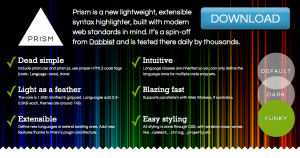 For the past three weeks, on and off, I’ve been working on releasing Dabblet’s syntax highlighter as standalone, since many people had requested it. Zachary Forrest suggested the name “Prism” and I liked it so much I decided to go with it, even though there is an abandoned Mozilla project with the same name. I ended up refactoring and extending it so much that I will need to backport it to Dabblet one of these days! This doesn’t mean I bloated it, the core is still a tiny 1.5KB minified & gzipped. It just means it’s more awesome. 🙂
For the past three weeks, on and off, I’ve been working on releasing Dabblet’s syntax highlighter as standalone, since many people had requested it. Zachary Forrest suggested the name “Prism” and I liked it so much I decided to go with it, even though there is an abandoned Mozilla project with the same name. I ended up refactoring and extending it so much that I will need to backport it to Dabblet one of these days! This doesn’t mean I bloated it, the core is still a tiny 1.5KB minified & gzipped. It just means it’s more awesome. 🙂
Seriously? The world needs another syntax highlighter?
In certain ways, Prism is better than any other syntax highlighter I’ve seen:
- It’s tiny. The core is only 1.5KB minified & gzipped, which can go up to 2KB with the currently available language definitions (CSS, Markup and JS). But many other highlighters are also small, so read on.
- It’s incredibly extensible. Not only it’s easy to add new languages (that’s a given with every syntax highlighter these days), but also to extend existing ones. Most importantly, it supports plugins, through hooks strategically placed in its source. There are a few plugins already available, and it’s really easy to write your own. I haven’t seen any other highlighter that supports plugins.
- It encourages good author practices. Other highlighters encourage or even force you to use elements that are semantically wrong, like <pre> (on its own) or <script>. Prism forces you to use the only semantically correct element for marking up code: <code>. On its own for inline code, or inside a <pre> for blocks of code. In addition, the code language is declared through the way recommended in the HTML5 draft: through a language-xxxx class.
- One of its best features: The language definition is inherited. This means that if multiple code snippets have the same language, you can just define it once, in one of their common ancestors. Obviously, if you define a language on the <body> element, you’ve essentially declared a default language for the entire document.
- It looks good. All three of its existing themes. Most people wanted me to release Dabblet’s highlighter because they found other highlighters (including their themes) quite ugly.
- It supports parallelism through Web Workers, for better performance in certain cases.
- It doesn’t force you to use any Prism-specific markup, not even a Prism-specific class name, only standard markup you should be using anyway. So, you can just try it for a while, remove it if you don’t like it and leave no traces behind.
However, there are some limitations too:
- Pre-existing HTML in the code block will be stripped off. However, there are plugins for links and highlighting certain lines.
- I decided not to support IE8. Prism won’t break on IE8, it just won’t work. I don’t think many people using IE8 and below are able to read code, so I don’t see the point.
Enjoy: prismjs.com
If you like this project, don’t forget to follow @prismjs on Twitter!
I’ll soon update this blog to use Prism in the code examples as well.
